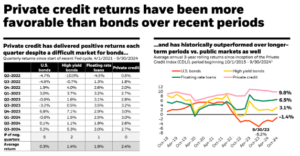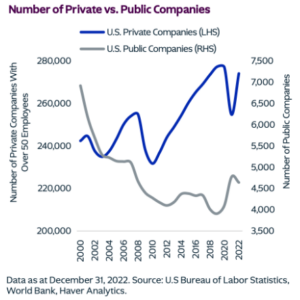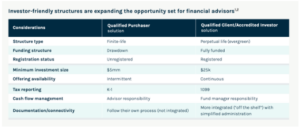
How “Smart Money” Goes Beyond the Market
If you’ve already maxed your 401(k)s, squeezed every basis point from index funds, and harvested every ounce of diversification traditional markets offer, this one is for you.
You’ve entered the portfolio frontier, where new money isn’t just about safety, but smart, calculated risk. That usually brings you to private markets and alternative investments.
Here’s the gist: private markets promise higher returns, lower correlation to public markets, and a degree of exclusivity, but they also come with real trade-offs, like illiquidity and accredited investor requirements.
An accredited investor, by definition, is someone with a net worth over $1 million (excluding primary residence), or income over $200K ($300K with a spouse). This status is your basic entry ticket into most private equity (PE) and alternative strategies.
So, are they worth it?
The Performance Premium: What the Numbers Say
The strongest case for private equity and its alt cousins, private credit, real estate, and infrastructure, rests on performance.
Over the nine-year period ending September 30, 2024:
- Private credit delivered an average annualized return of 9.8%,
- Compared to just 3.1% for U.S. bonds and 6.5% for high-yield bonds

(Source: BlackRock “Student of the Private Markets” Q1 2025 report, p. 5)
Private credit also had zero negative quarters from Q2 2022 through Q3 2024. Public bonds had five. That’s structural insulation.
Private equity showed a similar edge, generating a 13% net return over 10 years through Q3 2023, outpacing every major public benchmark, including large-cap and mid-cap U.S. equities.

(Source: KKR “5 Things for Wealth,” Exhibit 2)
Compounding in private markets isn’t just a theory, it’s tangible. When layered well (equity, credit, real estate, infrastructure), private portfolios protect capital and drive long-term wealth growth.
Illiquidity Is a Behavioral Firewall
One of private equity’s greatest features is also its biggest challenge: illiquidity.
Multiple studies show that enforced illiquidity protects investors from impulsive behavior. No tickers. No panic sells. No daily FOMO. Just long-term, time-stamped commitment.
The benefit? Behavioral discipline. Impulse kills compounding, and PE insulates you from yourself.
This isn’t about “diversification.” It’s about building a portfolio that performs even when you’re distracted, emotional, or simply busy living your life.
Public Markets Are Shrinking
The opportunity set in public markets is no longer what it used to be. Since the early 2000s:
- The number of public companies in the U.S. has dropped by over 30%
- Meanwhile, there are nearly 270,000 private companies with 50+ employees, but fewer than 5,000 public ones

(Source: KKR “5 Things for Wealth,” Exhibit 4)
Private equity isn’t just targeting startups anymore. It’s scooping up mature, cash-flowing businesses, companies that would’ve IPO’d a decade ago, but now stay private longer (or permanently).
If you’re only investing in public markets, you’re missing where most growth and innovation now live.
Want to Go a Bit Deeper?
Check out our Private Equity & Alternatives YouTube Short where we explore:
- What they are
- Why they matter
- How we’re using them in real portfolios today
Barriers Are Falling
Ten years ago, getting into private equity required $5M and an elite network. Today?
Investor-friendly structures are making real alternatives available to more people:
- Monthly liquidity
- 1099 reporting (instead of K-1s)
- Lower minimums (as low as $25K)

(Source: Ares “Private Market Insights” 2023)
Tech is transforming access, think digital onboarding, rolling capital calls, and smart allocation tools.
But don’t confuse ease of entry with ease of management. You still need:
- Diligent fund selection
- Clear capital commitment timelines
- A willingness to understand complexity
The walls are coming down. But you still need a blueprint.
Making Sense of PE and Alternative Investments
You’ve heard it before: Past performance is no guarantee of future results.
But the inverse is also true: Past inertia guarantees nothing either.
Private markets aren’t a passing trend. They’re part of a structural redefinition of where value is created and how wealth is built.
So, are they worth it?
✅ Yes, if you:
- Have long-term capital
- Don’t need liquidity for 7–10 years
- Are looking to diversify from public markets
- Want exposure to the “real economy” where most companies now live
❌ No, if you:
- Might need the funds in 3 years
- Already feel stretched with portfolio complexity
- Aren’t ready to navigate fund vetting, access rules, and capital calls
Final Thought
Private markets offer asymmetric potential, but they are not automatic wins. You must still consider:
- Fees
- Capital timing
- Manager access and quality
- Lockup periods
This isn’t a playground. It’s a long-term commitment. Even a small allocation demands real conviction and a tailored plan.
We help investors build portfolios that go beyond the 60/40, ones that embrace alternatives as part of a modern, inflation-aware, risk-managed strategy.
